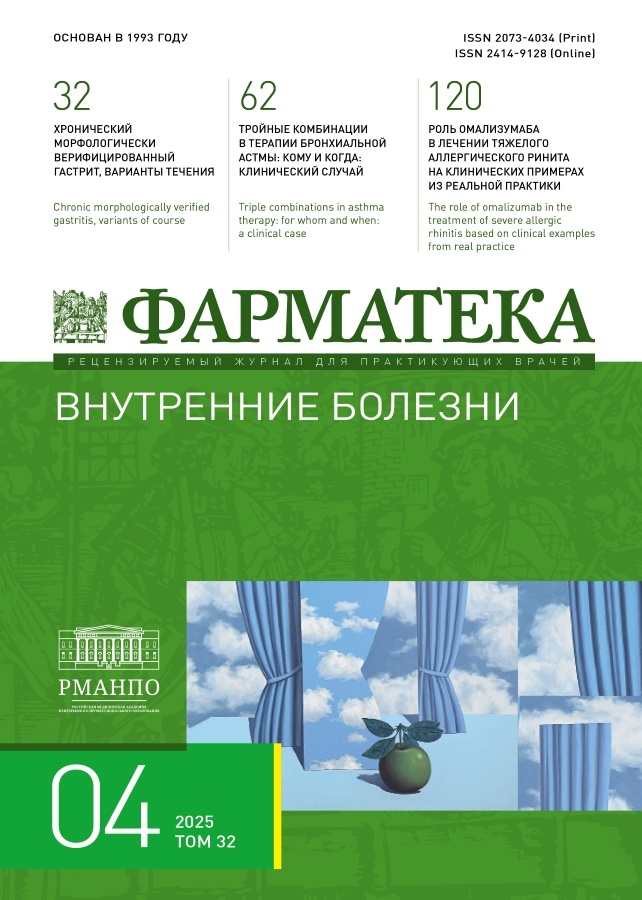Сравнительный анализ микробного пейзажа отделений хирургического профиля многопрофильных стационаров г. Петрозаводска (Республика Карелия)
- Авторы: Рябкова Н.Л.1,2, Ильина Н.А.3, Громова Г.А.4, Рябков В.А.1,2
-
Учреждения:
- Петрозаводский государственный университет
- Республиканская больница им. В.А. Баранова
- Республиканская больница скорой и экстренной медицинской помощи
- Республиканский онкологический диспансер
- Выпуск: Том 32, № 4 (2025)
- Страницы: 212-220
- Раздел: Восстановительная медицина
- URL: https://journals.eco-vector.com/2073-4034/article/view/687771
- DOI: https://doi.org/10.18565/pharmateca.2025.4.212-220
- ID: 687771
Цитировать
Полный текст
Аннотация
Обоснование: Резистентность к антимикробным препаратам – одна из наиболее актуальных проблем в здравоохранении, в т.ч. в развитых странах. Локальный мониторинг необходим для своевременной коррекции протоколов эмпирической антимикробной терапии нозокомиальных инфекций в конкретном лечебно-профилактическом учреждении и проведения противоэпидемических мероприятий.
Цель исследования: провести сравнительный анализ этиологической структуры и чувствительности основных возбудителей нозокомиальных инфекций отделений хирургического профиля к антимикробным препаратам (АМП) в 2023 г. в трех многопрофильных стационарах Петрозаводска: ГБУЗ «Республиканская больница им. В.А. Баранова» (ГБУЗ РБ), ГБУЗ «Республиканская больница скорой и экстренной медицинской помощи» (ГБУЗ БСМП) и ГБУЗ «Республиканский онкологический диспансер» (ГБУЗ РОД).
Материалы и методы: Проведен анализ всех микробиологических исследований, выполненных в 2023 г. в трех стационарах третьего уровня Петрозаводска. Проведена сводка данных, статистическая группировка с последующим графическим представлением полученной информации.
Результаты: Среди микробиологических исследований в отделениях анестезиологии и реанимации преобладали анализы мокроты. Основными возбудителями нозокомиальных инфекций нижних дыхательных путей в ГБУЗ РБ и ГБУЗ БСМП были Klebsiella pneumoniae (34,88 и 35,23%), Staphylococcus aureus (19,77 и 19,32%), Acinetobacter baumannii (15,12 и 10,22%) и Pseudomonas aeruginosa (8,14 и 10,22%). Отмечена устойчивость A. baumannii ко всем АМП и невысокая чувствительность всех ведущих возбудителей к цефтазидиму в ГБУЗ РБ. В хирургических отделениях всех стационаров чаще исследовалось раневое отделяемое: в ГБУЗ РБ преобладал S. aureus, в двух других стационарах – Escherichia coli. Отмечалась низкая чувствительность грамотрицательных возбудителей к амикацину в ГБУЗ РБ, а также K. pneumoniae и P. aeruginosa к АМП в ГБУЗ РОД. В отделениях урологического профиля все микробиологические исследования представлены посевами мочи, основные возбудители – E. coli, K. pneumoniae и Enterococcus spp. Низкая чувствительность ко всем АМП характерна для K. pneumoniae в ГБУЗ РБ и РОД, к цефтазидиму – в ГБУЗ БСМП, P. aeruginosa – к цефтазидиму в ГБУЗ РБ. В травматологических отделениях ГБУЗ РБ и ГБУЗ БСМП преобладали исследования раневого отделяемого (84,05 и 86,67%), ведущим возбудителем был S. aureus. Чувствительность K. pneumoniae к амикацину, а также к цефтазидиму у всех основных грамотрицательных возбудителей в ГБУЗ РБ было ниже оптимальных значений. Ведущим возбудителем раневой инфекции в нейрохирургическом отделении ГБУЗ РБ был S. aureus, в ГБУЗ БСМП – E. coli. Отмечена низкая чувствительность K. pneumoniae и Proteus spp. ко всем АМП, а P. aeruginosa – к цефтазидиму в ГБУЗ РБ.
Заключение: В отделениях хирургического профиля трех ведущих многопрофильных стационаров Петрозаводска в качестве возбудителей нозокомиальных инфекций преобладает грамотрицательная микрофлора в сочетании с S. aureus. Меньшая чувствительность грамотрицательных возбудителей к АМП зарегистрирована в ГБУЗ РБ и ГБУЗ РОД.
Полный текст
Об авторах
Надежда Леонидовна Рябкова
Петрозаводский государственный университет; Республиканская больница им. В.А. Баранова
Автор, ответственный за переписку.
Email: nadl-ryabkova@yandex.ru
ORCID iD: 0000-0002-9434-7931
SPIN-код: 3652-4255
к.м.н., доцент кафедры госпитальной терапии медицинского института, Петрозаводский государственный университет; клинический фармаколог, Республиканская больница им. В.А. Баранова
Россия, Петрозаводск; ПетрозаводскНаталья Андреевна Ильина
Республиканская больница скорой и экстренной медицинской помощи
Email: nadl-ryabkova@yandex.ru
ORCID iD: 0009-0001-9555-1715
клинический фармаколог
Россия, ПетрозаводскГалина Александровна Громова
Республиканский онкологический диспансер
Email: nadl-ryabkova@yandex.ru
ORCID iD: 0009-0008-2406-7767
клинический фармаколог
Россия, ПетрозаводскВадим Александрович Рябков
Петрозаводский государственный университет; Республиканская больница им. В.А. Баранова
Email: nadl-ryabkova@yandex.ru
ORCID iD: 0000-0002-3353-3220
к.м.н., доцент, Центр постдипломного образования медицинского института, Петрозаводский государственный университет; врач-кардиолог, Республиканская больница им. В.А. Баранова
Россия, Петрозаводск; ПетрозаводскСписок литературы
- Методические рекомендации «Диагностика и антимикробная терапия инфекций, вызванных полирезистентными штаммами микроорганизмов (обновление 2022 г.)». URL: https://www.antibiotic.ru/iacmac/news/obnovlennye-metodicheskie-rekomendacii-diagnostika-i-antimikrobnaya-terapiya-infekcij-vyzvannyh-polirezistentnymi-shtammami-mikroorganizmov (ссылка доступна на 15.02.2025). [Guidelines «Diagnostics and antimicrobial therapy of infections caused by multidrug-resistant strains of microorganisms (2022 update)». URL: https://www.antibiotic.ru/iacmac/news/obnovlennye-metodicheskie-rekomendacii-diagnostika-i-antimikrobnaya-terapiya-infekcij-vyzvannyh-polirezistentnymi-shtammami-mikroorganizmov (link available on 15.02.2025). (In Russ.)].
- Naghavi M., et al. Global burden of bacterial antimicrobial resistance 1990–2021: a systematic analysis with forecasts to 2050. Lancet. 2024;404(10459):1199–226.
- Кисиль О.В., Габриэлян Н.И., Малеев В.В. Устойчивость к антибиотикам – что можно сделать? Терапевтический архив. 2023;95(1):90–5. [Kisil O.V., Gabrielyan N.I., Maleev V.V. Antibiotic resistance – what can be done? A review. Terapevticheskiy arkhiv. 2023;95(1):90–5. (In Russ.)]. https://dx.doi.org/10.26442/00403660.2023.01.202040
- Степанова Т.Ф., Катаева Л.В., Посоюзных О.В. и др. Структура ESKAPE-патогенов, изолированных от пациентов отделения реанимации и интенсивной терапии новорожденных Национального госпиталя педиатрии г. Ханой, Социалистическая Республика Вьетнам. Журнал микробиологии, эпидемиологии и иммунобиологии. 2023;100(2):168–77. [Stepanova T.F., Kataeva L.V., Posoyuznykh O.V., et al. The structure of ESKAPE pathogens isolated from patients of the neonatal intensive care unit at the National Hospital of Pediatrics in Hanoi, the Socialist Republic of Vietnam. J Microbiol Epidemiol Immunobiol. 2023;100(2):168–77. (In Russ.)]. https://doi.org/10.36233/0372-9311-329
- Кузьменков А.Ю., Виноградова А.Г., Трушин И.В. и др. AMRmap – система мониторинга антибиотикорезистентности в России. Клиническая микробиология и антимикробная химиотерапия. 2021;23(2):198–204. [Kuzmenkov A.Yu., Vinogradova A.G., Trushin I.V., et al. AMRmap – antibiotic resistance surveillance system in Russia. Clin Microbiol Antimicrob Chemother. 2021;23(2):198–204. (In Russ.)]. https://dx.doi.org/10.36488/cmac.2021.2.198-204
Дополнительные файлы


















